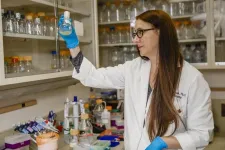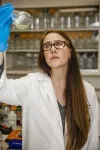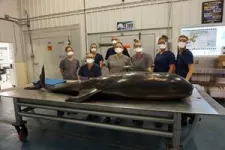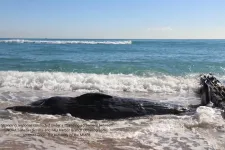(Press-News.org)
Most chronic wound infections share one thing in common: the presence of biofilms, which are composed of many different microorganisms that congregate as a mass, usually on some type of surface such as a wound bed. Biofilms are thought to be associated with up to 80% of infections, and their ability to stick together makes the biofilm and infection exceptionally difficult to kill.
To combat this health care challenge, researchers such as Kendra Rumbaugh, Ph.D., a professor in the Texas Tech University Health Sciences Center (TTUHSC) School of Medicine’s Department of Surgery, are pursuing biofilm dispersal agents such as specific enzymes in hopes the enzymes can induce microbes to leave the safety of the protective biofilm and become more susceptible to antibiotics. Rumbaugh’s efforts received a funding boost in December when she was awarded a two-year, $434,938 grant (“Bacterial and host response to biofilm dispersal in wound infections”) from the National Institute of Allergy and Infectious Diseases at the National Institutes of Health.
Rumbaugh’s lab has for years focused on researching biofilms — specifically, bacterial biofilms — and their role in wound infections. She said biofilms are problematic in many different types of infections, especially chronic infections where theirformation makes the wound’s microbial components exceptionally resistant to treatment. By focusing on wound infections, Rumbaugh’s lab found that when certain types of bacteria (some more than others) get into a wound, they very often will form a biofilm.
“The bacteria and microbes slow down their metabolism and become almost dormant,” Rumbaugh said. “They go to sleep and surround themselves with an extracellular polymeric substance (EPS), a sticky substance that covers them and protects them, and then they just hunker down.”
Even though the bacteria become dormant in the biofilm, Rumbaugh said past research indicates that the immune system knows the bacteria and the biofilm are there, and it's responding by producing a variety of things that are supposed to kill the bacteria. However, because the bacteria are embedded in this biofilm, none of those things work, which leads to prolonged inflammation and inhibited wound healing.
“The bacteria are inhibiting the wound from closing and healing, and it's really hard for the immune system to kill them,” Rumbaugh said. “It’s also really hard for antibiotics to kill them for basically the same reason: they're dormant and they're covered up in the biofilm.”
With this new grant, Rumbaugh’s lab will use certain enzymes as tools to understand what happens to bacteria when they're dispersed from a biofilm rather than working to identify a suitable enzyme for commercialization purposes. They also want to investigate the effects that dispersing a quantity of bacteria from a biofilm produces in the host.
Rumbaugh’s lab has for years been examining the enzymes they hypothesized would break up the bonds that are present in the biofilm. Rumbaugh believes these enzymes, called glycoside hydrolases, actually will break up the EPS and uncover the bacteria so it can be killed by antibiotics.
“Using the enzymes is considered a passive method for dispersing bacteria from a biofilm because the bacteria aren't really participating in an active way,” Rumbaugh explained. “We're hitting them with an enzyme that breaks up the EPS, and then they're uncovered. They do move out of the biofilm, but it's not the bacteria that are initiating the process of dispersal, so we call that passive dispersal.”
There also are active dispersal methods that can induce different signal transduction pathways in bacteria that cause the bacteria to initiate dispersal themselves. In addition, there are many different characterizations of what happens to bacteria when they are dispersed specifically from a wound.
In this grant, Rumbaugh’s lab will compare several passive and active dispersal methods using different chemical signals, enzymes and processes. As they investigate, Rumbaugh said they will attempt to determine what happens to the bacteria during dispersal. Do they become more virulent or more destructive to the host? On the other hand, they also will be investigating what happens to the host (a mouse in this case) and how it responds over time as the bacteria are dispersed and move systematically through the bloodstream of the mouse.
Rumbaugh said there is also some evidence shown by others that dispersal causes bacteria to alter their gene transcription (the process by which a DNA segment is copied into RNA) in ways that then affect their susceptibility to antibiotics. Therefore, her lab also will investigate whether dispersal alters and influences the bacteria’s susceptibility to antibiotics and other drugs based on the dispersal method being employed.
“That’s important to know if you're banking on the fact that you're going to be able to kill them with antibiotics,” Rumbaugh said. “This project will provide more of a basic science understanding of bacterial dispersal from biofilms. I also think this information is important if we're going to have therapeutics that trigger or capitalize on dispersal in some way in the future. We really need to understand exactly what dispersal is doing to the bacteria and what it's doing to the host. That’s the primary focus of our study in a nutshell.”
###
END
Whales and dolphins get their nutrients and essential elements through their diet. While eating fish, squid, octopus, crustaceans and other marine mammals, they are also exposed to heavy metal contaminants.
Elevated levels of toxins have been found in stranded dolphins and whales along the Southeastern Coast of the United States. Monitoring toxic contaminants in these stranded marine animals, which serve as important sentinels of environmental contamination, and whose health may be linked to human health, is vital.
Yet, data remain sparse on how specific elements are distributed within an animal’s body, especially for many rarely encountered ...
Racially biased readings of oxygen levels in the blood using pulse oximeters may further limit opportunities for Black patients with heart failure to receive potentially lifesaving treatments, such as heart pumps and transplants, a Michigan Medicine study finds.
“This is especially important because we know that Black patients are already less likely to receive heart pumps or transplants compared to their white counterparts, and these inaccurate readings can further widen a disparity that must be addressed by our health care system,” said first author Scott W. Ketcham, M.D., a third year ...
KANSAS CITY, MO—February 21, 2024—The sea lamprey, a 500-million-year-old animal with a sharp-toothed suction cup for a mouth, is the thing of nightmares. A new study from the Stowers Institute for Medical Research discovered that the hindbrain—the part of the brain controlling vital functions like blood pressure and heart rate—of both sea lampreys and humans is built using an extraordinarily similar molecular and genetic toolkit.
Research from the lab of Investigator Robb Krumlauf, Ph.D., published on February 20, 2024 in Nature Communications offers a glimpse into how the brains of ancient animals evolved. The team unexpectedly uncovered that ...
As part of the New Deal, several governmental programs were created to expand homeownership through mortgages and loans. However, neighborhoods with primarily Black or immigrant communities often were rated “hazardous” for repayment under the discriminatory, “redlining” practice that restricted lending. Today, those same areas are exposed to more air pollution than other urban neighborhoods, and according to research published in ACS’ Environmental Science & Technology, the cause could ...
Tuna is one of the most popular seafoods worldwide. But this protein-rich fish can build up high levels of methylmercury from feeding on contaminated prey, like smaller fish or crustaceans. Despite efforts to reduce mercury emissions into the environment, researchers report in ACS’ Environmental Science & Technology Letters that levels in tuna appear to be unchanged since 1971. They warn that more aggressive emission reduction targets are needed to start nudging down tuna mercury levels.
Environmental ...
With ever-increasing life expectancy comes the challenge of treating age-related disorders such as osteoporosis. Although there are effective drugs for treating this metabolic bone disease, they can be expensive and have side effects, limiting their availability to some people. In the search for alternative drug candidates, researchers reporting in ACS Central Science have discovered and fully replicated a compound from a botanical source, female ginseng, that had potent anti-osteoporotic activity in cellular tests.
Osteoporosis and low bone mass impact 54 million American ...
History determines who gets to breathe fresh air, according to a new study published today in Environmental Science and Technology. The CIRES led-study found that historic, discriminatory lending practices known as redlining in the city are linked to inequities in air quality today.
Alex Bradley, a fourth-year chemistry Ph.D. student in CIRES’ de Gouw group at the University of Colorado Boulder, used his background in chemistry coupled with an environmental justice lens to understand how pollution impacts communities of color in Denver.
What he discovered wasn’t ...
As people with autism grow up, they face unique challenges. They find it difficult to deal with mental health issues. There is a big gap in understanding how pretending to fit in (known as social camouflage), cultural beliefs, and mental well-being are connected. This is especially true for non-Western countries like Japan. In societies that stress conformity, autistic individuals may feel more pressure to act non-autistic. This, in turn, affects their mental health. Not enough studies in Japan have investigated this concern, which leaves a crucial gap in our ...
The Asian Fund for Cancer Research (AFCR) proudly recognizes the exceptional contributions of Dr. Yung-Chi Cheng, AFCR Scientific Advisory Board Member, and Henry Bronson Professor of Pharmacology and Medicine at Yale University. Dr. Cheng's unwavering commitment over the past thirty years has led to the establishment of Yiviva, a clinical-stage platform biotechnology company dedicated to developing transformative medicines targeting cancer and aging-related diseases.
AFCR was the early champion behind Dr. Yung-Chi Cheng's pursuit of applying a systems biology approach ...
PULLMAN, Wash. -- Students tend to like friendly teachers, but they like those who believe they can improve even more, new research indicates.
Students in a study still responded positively to instructors described as being cold but who also had a growth mindset, meaning they felt students’ ability in a subject could improve by working hard and trying different strategies. The opposite was also true: more participants reacted negatively to a warm, smiling teacher when they stated a fixed mindset, which is a belief that innate abilities cannot be changed, such as someone being naturally good at math.
“It's not enough to just be nice,” said lead author Makita ...






